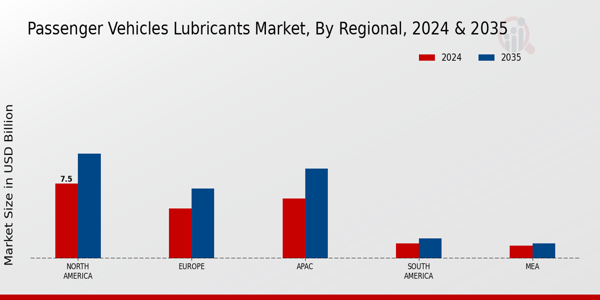Rising Consumer Awareness
Consumer awareness regarding vehicle maintenance and the importance of quality lubricants is significantly influencing the Passenger Vehicles Lubricants Market. As individuals become more informed about the benefits of using high-performance lubricants, they are increasingly opting for premium products that enhance engine efficiency and prolong vehicle life. This trend is reflected in the growing sales of synthetic and semi-synthetic lubricants, which are perceived as superior alternatives to conventional oils. Additionally, educational campaigns by lubricant manufacturers and automotive service providers have contributed to this heightened awareness. As a result, the demand for specialized lubricants tailored to specific vehicle types is likely to increase, further driving the Passenger Vehicles Lubricants Market.
Increasing Vehicle Production
The rise in vehicle production is a pivotal driver for the Passenger Vehicles Lubricants Market. As manufacturers ramp up production to meet consumer demand, the need for high-quality lubricants becomes paramount. In recent years, the automotive sector has witnessed a steady increase in production rates, with millions of passenger vehicles being manufactured annually. This surge necessitates the use of advanced lubricants to ensure optimal engine performance and longevity. Furthermore, the growing trend of electric vehicles, which still require lubricants for various components, adds another layer of complexity to the market. Consequently, the Passenger Vehicles Lubricants Market is poised for growth as manufacturers seek to enhance vehicle efficiency and reduce emissions through superior lubrication solutions.
Growth of Aftermarket Services
The expansion of aftermarket services is a crucial driver for the Passenger Vehicles Lubricants Market. As vehicle ownership increases, so does the demand for maintenance and repair services, which often include lubricant changes. This trend is particularly pronounced in regions with a high density of vehicles, where consumers are more likely to seek professional services for their vehicles. Additionally, the rise of online platforms for purchasing lubricants has made it easier for consumers to access a wide range of products, further fueling the aftermarket segment. As a result, the Passenger Vehicles Lubricants Market is expected to benefit from this growing trend, as more consumers prioritize regular maintenance and the use of quality lubricants.
Regulatory Compliance and Standards
The stringent regulatory environment surrounding emissions and fuel efficiency is a significant driver for the Passenger Vehicles Lubricants Market. Governments worldwide are implementing regulations that mandate lower emissions and improved fuel economy, compelling manufacturers to develop lubricants that meet these standards. For instance, the introduction of new API (American Petroleum Institute) standards has prompted lubricant producers to innovate and create products that not only comply with regulations but also enhance vehicle performance. This regulatory pressure is expected to continue, pushing the industry towards the development of eco-friendly and high-performance lubricants. Consequently, the Passenger Vehicles Lubricants Market is likely to experience growth as manufacturers adapt to these evolving standards.
Technological Innovations in Lubricants
Technological advancements in lubricant formulations are driving the evolution of the Passenger Vehicles Lubricants Market. Innovations such as the development of advanced synthetic oils and additives are enhancing the performance characteristics of lubricants, leading to improved fuel efficiency and engine protection. These innovations are particularly relevant as vehicles become more sophisticated, requiring lubricants that can withstand higher temperatures and pressures. The introduction of smart lubricants, which can provide real-time data on engine performance, is also gaining traction. As these technologies continue to evolve, they are expected to reshape the Passenger Vehicles Lubricants Market, offering consumers more effective and efficient lubrication solutions.


















Leave a Comment